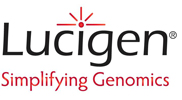
- ExpressgenesclonedintoanyT7vectorwiththeseBL21(DE3)derivatives
- Effectiveinexpressingtoxic&membraneproteins
- Citedinover350researcharticles
- InterestedinacompetentE.colistrainforroutineproteinexpression?Lookhere
E.coliBL21(DE3)strains,likeLucigen’sE.cloni®EXPRESSCompetentCellsprovidereliableexpressionofmanygenesclonedintoT7expressionvectors(e.g.,pETorLucigen’spSMART®-CDNAvectors).However,insomecasesexpressionisminimalornotdetectablebecausetherecombinantprotein,whenexpressed,isdeleteriousorlethaltothesestandardBL21strains.Examplesofsuchtoxicproteinsincludemanymembraneproteins,somecytoplasmicproteins,andnucleases.Unfortunately,successfulexpressionofoneormoretoxicproteinsisoftenimportanttotheexperimentalgoal.
Lucigen’sOverExpressElectrocompetentandChemicallyCompetentCellsareE.colistrainsthatareeffectiveinexpressingtoxicproteinsfromallclassesoforganisms,includingeubacteria,yeasts,plants,viruses,andmammals.Theeffectivenessofthesenewstrainsinexpressingtoxicproteinshasbeenvalidatedinmorethan350publications.
TheOverExpressstrainscontaingeneticmutationsphenotypicallyselectedforconferringtolerancetotoxicproteins.ThestrainC41(DE3)wasderivedfromBL21(DE3).Thisstrainhasatleastonemutation,whichpreventscelldeathassociatedwithexpressionofmanyrecombinanttoxicproteins.ThestrainC43(DE3)wasderivedfromC41(DE3)byselectingforresistancetoadifferenttoxicproteinandcanexpressadifferentsetoftoxicproteinstoC41(DE3).Figure1graphicallyillustratestheadvantagesoftheOverExpressCompetentCells,comparedtostandardBL21(DE3)cells,inexpressingtoxicproteins.
|
Figure1.GreenFluorescentProtein(top)orRedFluorescentProtein(bottom)expressedfromaT7promoterconstructthatwastransformedintoC41,BL21,orC43competentcellsspreadonIPTGplatestoinduceproteinexpression. |
Table1andFigure2summarizetransformationeffectiveness,toleranceofexpression-inducedtoxicity,andproteinexpressionforT7expressionplasmidscodingforavarietyofrecombinantproteins.TheseresultsdemonstratethattheOverExpressC41(DE3)andC43(DE3)strainsareclearlysuperiortotheparentalBL21(DE3)intransformationandexpressionoftoxicproteins.
Table1.ComparisonofOverExpressC41(DE3)andC43(DE3)cellswiththeparentalstrainBL21(DE3)intransformationandexpressionofheterologousproteins.**
| Strain | Transformation SuccessRatea | Expression-inducedToxicityb | ExpressingPlasmidsc |
BL21(DE3) | 16/26(62%) | 25/26(96%) | 14/26(54%) |
C41(DE3) | 28/28(100%) | 14/28(50%) | 24/28(86%) |
C43(DE3) | 28/28(100%) | 1/28(4%) | 23/28(81%) |
|
Figure2.ComparisonofOverExpressC41(DE3)andC43(DE3)cellswiththeparentalstrainBL21(DE3)intransformationandexpressionofheterologousproteins.** |
aTransformationsuccesscorrespondstothepresenceofcoloniesonLB+ampicillinagarfollowingtransformationwithaplasmid.
bExpressiontoxicitycorrespondstotheabsenceofcoloniesonLB+ampicillin+IPTGagarfollowingtransformationwithaplasmid.
cExpressingplasmidscorrespondstoobservationofaheterologousproteininthetotalcellpelletonCoomassie-stainedSDS-PAGEfollowinggrowthofacolonyinLB+ampicillinmediumandinductionwithIPTG.
**L.Dumon-Seignovert,G.Cariot,andL.Vuillard(2004).ProteinExpressionandPurification37,203-206.Datausedwithpermission.
AsinstandardBL21(DE3)strains,OverExpressC41(DE3),C41(DE3)pLysS,C43(DE3),andC43(DE3)pLysSarelysogensof&lamBDa;DE3.ThesestrainscarryachromosomalcopyoftheT7RNAPolymerasegeneunderthecontrolofthelacUV5promoter.ThesestrainsaresuitableforproductionofproteinfromtargetgenesclonedintoT7-drivenexpressionvectors.OverExpressC41(DE3),C41(DE3)pLysS,C43(DE3),andC43(DE3)pLysSarealsodeficientinthelonandompTproteases.
OverExpressC41(DE3)pLysSandC43(DE3)pLysSalsocarryachloramphenicol-resistantplasmidthatencodesT7lysozyme,whichisanaturalinhibitorofT7RNApolymerase.CellscontainingpLysSproduceasmallamountofT7lysozyme.ThesestrainsareusedtosuppressbasalexpressionofT7RNApolymerasepriortoinduction,thusstABIlizingrecombinantsencodingparticularlytoxicproteins.
FAQWhichOverExpresscellstrainshouldIuse?
ItisdifficulttopredictwhichofthefourOverExpressstrains–C41(DE3),C43(DE3),C41(DE3)pLysS,orC43(DE3)pLysS–willworkbestinexpressingagivenprotein.WerecommendinitiallyusingtheOverExpressComboPack™whichcontains3reactionseachofthefourOverExpresscompetentcellstrains,todeterminewhichoneisbestforyourapplication.TheOverExpressstrainsareavailableaselectrocompetentorchemicallycompetentcells.
Becausetherearenointrinsicantibioticresistances(orplasmids)ineitherC41(DE3)orC43(DE3),thestrainscanbedifferentiatedfromeachotherandfromBL21(DE3)bytransformationwithastrainverificationvector,pAVD10.pAVD10containstheuncFgene(encodingthebeta-subunitofE.coliATPase)underthecontroloftheT7promoter.ThisplasmidislethaltoBL21(DE3)andtoinducedC41(DE3),butitistoleratedbyC43(DE3)regardlessofinduction.pAVD10isprovidedwithOverExpressCells.
ORDERINFORMATION
EachOverExpresskitcontainsElectrocompetentorChemicallyCompetentCellsinSOLOpackaging(1transformationpertube),ExpressionRecoveryMedium(lactoseminus),pUC19PositiveControlPlasmid,pAVD10VerificationPlasmid,andcompleteprotocols.ComboPackscontain3reactionseachofchemicallycompetentC41(DE3),C43(DE3),C41(DE)pLysS,andC43(DE3)pLysS.ebiomall.com






>
>
>
>
>
>
>
>
>
>
>
>
大家好,本人实验小白一枚,目前在寻找自己的毕业课题,有个实验问题想请教论坛里面的各位大侠。前期的实验证明某个转录因子具有抑癌作用,在正常肝脏组织中高表达,在肝癌组织中低表达,在HepG2,SMMC-7721等肝癌细胞株中缺失表达。我现在想用染色质免疫共沉淀结合高通量测序的方法筛选它的下游基因,由于在肝癌细胞株中缺失表达,我可以构建一个过表达转录因子的质粒到肝癌细胞株中做染色质免疫共沉淀吗?或者还有更好的方法筛选下游基因吗?谢谢!
基因表达(gene expression)是指细胞在生命过程中,把储存在DNA顺序中遗传信息经过转录和翻译,转变成具有生物活性的蛋白质分子。即表达=转录+翻译
转录量和拷贝数是相等的(产生的RNA),但和表达量(蛋白质,最终产物)不同意思,只是表达的第一步,只有转录的也都同样顺利翻译成蛋白质才有同时满足的可能。
转录增加 不等于 表达增加表达增加 也不等于 转录增加成功转录 不代表 成功表达成功表达 说明 成功转录
翻译是指mRNA在核糖体的帮助下翻译成肽链
基因表达则是二者的统一,即DNA转录成RNA,RNA翻译成肽链,并最终折叠成有意义的蛋白质
但严格来说,还是有区别的。因为基因的表达产物包括蛋白质和RNA(rRNA和tRNA)。如果产物是蛋白质,就是转录翻译;如果产物是RNA,就只是转录过程,没有翻译过程。
请教各位,我是做在体实验,在体给予刺激30分钟后观察蛋白的表达变化,结果是蛋白表达升高,但有人质疑30分钟这么短的时间能否真的引起蛋白表达的明显变化,所以请教各位,一般蛋白从转录到表达需要多长时间?
如题,我现在做出了一个蛋白相对于正常组织,在肿瘤里表达升高。想做某转录因子调控它的表达。查了转录因子预测的网站,每个预测的都很不一样,而且参与其调控的转录因子有几十个。我该怎么办呢?用什么实验技术或者方法能找到一个能做的呢?











